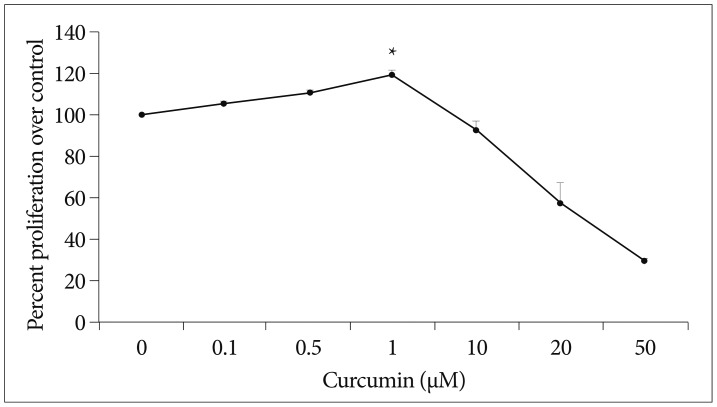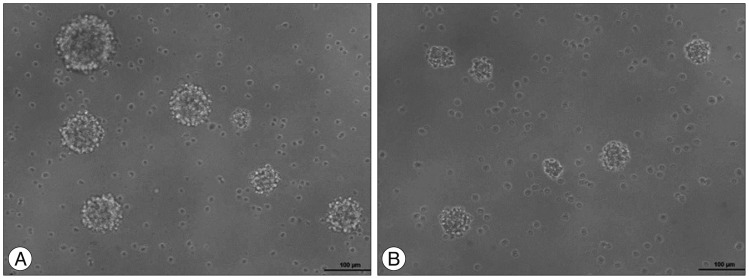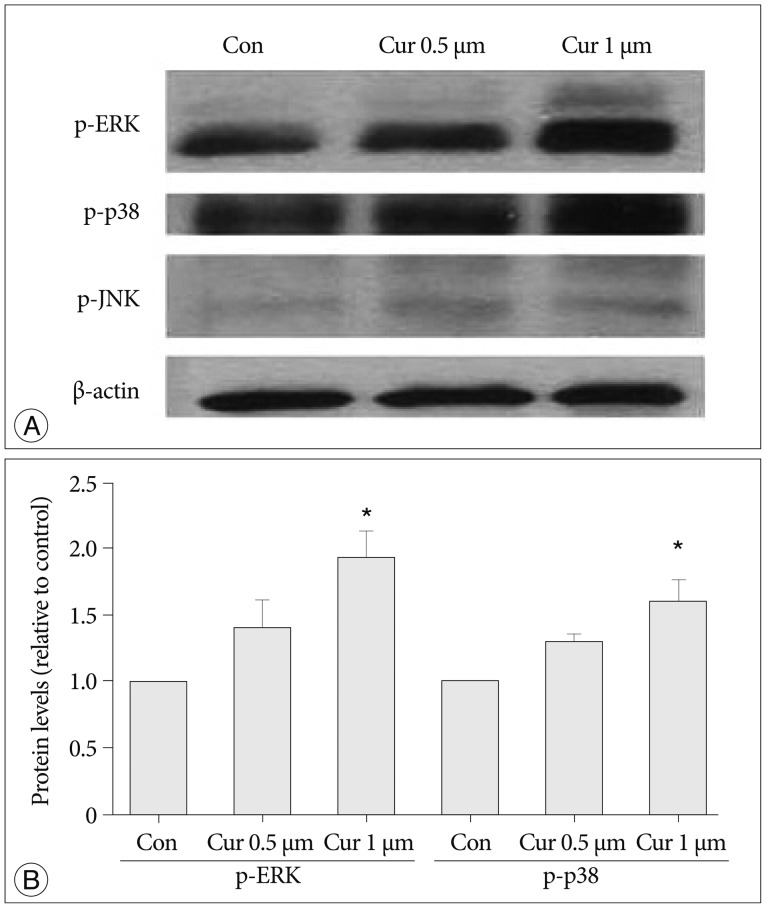J Korean Neurosurg Soc.
2014 Jul;56(1):1-4. 10.3340/jkns.2014.56.1.1.
Curcumin Stimulates Proliferation of Spinal Cord Neural Progenitor Cells via a Mitogen-Activated Protein Kinase Signaling Pathway
- Affiliations
-
- 1Department of Neurosurgery, Kyungpook National University Hospital, Daegu, Korea. nskimkt7@gmail.com
- 2Department of Physiology, School of Medicine, Kyungpook National University, Daegu, Korea.
- KMID: 2067068
- DOI: http://doi.org/10.3340/jkns.2014.56.1.1
Abstract
OBJECTIVE
The aims of our study are to evaluate the effect of curcumin on spinal cord neural progenitor cell (SC-NPC) proliferation and to clarify the mechanisms of mitogen-activated protein (MAP) kinase signaling pathways in SC-NPCs.
METHODS
We established cultures of SC-NPCs, extracted from the spinal cord of Sprague-Dawley rats weighing 250 g to 350 g. We measured proliferation rates of SC-NPCs after curcumin treatment at different dosage. The immuno-blotting method was used to evaluate the MAP kinase signaling protein that contains extracellular signal-regulated kinases (ERKs), p38, c-Jun NH2-terminal kinases (JNKs) and beta-actin as the control group.
RESULTS
Curcumin has a biphasic effect on SC-NPC proliferation. Lower dosage (0.1, 0.5, 1 microM) of curcumin increased SC-NPC proliferation. However, higher dosage decreased SC-NPC proliferation. Also, curcumin stimulates proliferation of SC-NPCs via the MAP kinase signaling pathway, especially involving the p-ERK and p-38 protein. The p-ERK protein and p38 protein levels varied depending on curcumin dosage (0.5 and 1 microM, p<0.05).
CONCLUSION
Curcumin can stimulate proliferation of SC-NPCs via ERKs and the p38 signaling pathway in low concentrations.
MeSH Terms
Figure
Cited by 1 articles
-
Curcumin Increase the Expression of Neural Stem/Progenitor Cells and Improves Functional Recovery after Spinal Cord Injury
Woo-Seok Bang, Kyoung-Tae Kim, Ye Jin Seo, Dae-Chul Cho, Joo-Kyung Sung, Chi Heon Kim
J Korean Neurosurg Soc. 2018;61(1):10-18. doi: 10.3340/jkns.2017.0203.003.
Reference
-
1. Alvarez-Buylla A, García-Verdugo JM, Tramontin AD. A unified hypothesis on the lineage of neural stem cells. Nat Rev Neurosci. 2001; 2:287–293. PMID: 11283751.
Article2. Arias-Carrión O, Olivares-Buñuelos T, Drucker-Colín R. [Neurogenesis in the adult brain]. Rev Neurol. 2007; 44:541–550. PMID: 17492613.3. Basnet P, Skalko-Basnet N. Curcumin : an anti-inflammatory molecule from a curry spice on the path to cancer treatment. Molecules. 2011; 16:4567–4598. PMID: 21642934.
Article4. Calabrese V, Butterfield DA, Stella AM. Nutritional antioxidants and the heme oxygenase pathway of stress tolerance : novel targets for neuroprotection in Alzheimer's disease. Ital J Biochem. 2003; 52:177–181. PMID: 15141484.5. Chen CW, Liu CS, Chiu IM, Shen SC, Pan HC, Lee KH, et al. The signals of FGFs on the neurogenesis of embryonic stem cells. J Biomed Sci. 2010; 17:33. PMID: 20429889.
Article6. Dent P. Crosstalk between ERK, AKT, and cell survival. Cancer Biol Ther. 2014; 15:245–246. PMID: 24424114.
Article7. Gangwal RP, Bhadauriya A, Damre MV, Dhoke GV, Sangamwar AT. p38 Mitogen-activated protein kinase inhibitors : a review on pharmacophore mapping and QSAR studies. Curr Top Med Chem. 2013; 13:1015–1035. PMID: 23651481.
Article8. Geest CR, Coffer PJ. MAPK signaling pathways in the regulation of hematopoiesis. J Leukoc Biol. 2009; 86:237–250. PMID: 19498045.
Article9. Gupta SC, Kismali G, Aggarwal BB. Curcumin, a component of turmeric : from farm to pharmacy. Biofactors. 2013; 39:2–13. PMID: 23339055.
Article10. Gupta SC, Patchva S, Koh W, Aggarwal BB. Discovery of curcumin, a component of golden spice, and its miraculous biological activities. Clin Exp Pharmacol Physiol. 2012; 39:283–299. PMID: 22118895.
Article11. Joe B, Vijaykumar M, Lokesh BR. Biological properties of curcumin-cellular and molecular mechanisms of action. Crit Rev Food Sci Nutr. 2004; 44:97–111. PMID: 15116757.
Article12. Jurenka JS. Anti-inflammatory properties of curcumin, a major constituent of Curcuma longa : a review of preclinical and clinical research. Altern Med Rev. 2009; 14:141–153. PMID: 19594223.13. Kim JH, Park SH, Nam SW, Kwon HJ, Kim BW, Kim WJ, et al. Curcumin stimulates proliferation, stemness acting signals and migration of 3T3-L1 preadipocytes. Int J Mol Med. 2011; 28:429–435. PMID: 21519785.
Article14. Kim KT, Kim MJ, Cho DC, Park SH, Hwang JH, Sung JK, et al. The neuroprotective effect of treatment with curcumin in acute spinal cord injury : laboratory investigation. Neurol Med Chir (Tokyo). 2014; 54:387–394. PMID: 24477066.
Article15. Kim SJ, Son TG, Park HR, Park M, Kim MS, Kim HS, et al. Curcumin stimulates proliferation of embryonic neural progenitor cells and neurogenesis in the adult hippocampus. J Biol Chem. 2008; 283:14497–14505. PMID: 18362141.
Article16. Kwon BK, Fisher CG, Dvorak MF, Tetzlaff W. Strategies to promote neural repair and regeneration after spinal cord injury. Spine (Phila Pa 1976). 2005; 30(17 Suppl):S3–S13.
Article17. Kwon BK, Tetzlaff W, Grauer JN, Beiner J, Vaccaro AR. Pathophysiology and pharmacologic treatment of acute spinal cord injury. Spine J. 2004; 4:451–464. PMID: 15246307.
Article18. Li J, Lepski G. Cell transplantation for spinal cord injury : a systematic review. Biomed Res Int. 2013; 2013:786475. PMID: 23484157.19. Liu RH, Morassutti DJ, Whittemore SR, Sosnowski JS, Magnuson DS. Electrophysiological properties of mitogen-expanded adult rat spinal cord and subventricular zone neural precursor cells. Exp Neurol. 1999; 158:143–154. PMID: 10448426.
Article20. Liu ZQ, Xing SS, Zhang W. Neuroprotective effect of curcumin on spinal cord in rabbit model with ischemia/reperfusion. J Spinal Cord Med. 2013; 36:147–152. PMID: 23809530.
Article21. Lo V, Esquenazi Y, Han MK, Lee K. Critical care management of patients with acute spinal cord injury. J Neurosurg Sci. 2013; 57:281–292. PMID: 24091430.22. Lodha R, Bagga A. Traditional Indian systems of medicine. Ann Acad Med Singapore. 2000; 29:37–41. PMID: 10748962.23. McNally SJ, Harrison EM, Ross JA, Garden OJ, Wigmore SJ. Curcumin induces heme oxygenase 1 through generation of reactive oxygen species, p38 activation and phosphatase inhibition. Int J Mol Med. 2007; 19:165–172. PMID: 17143561.
Article24. Ménard C, Hein P, Paquin A, Savelson A, Yang XM, Lederfein D, et al. An essential role for a MEK-C/EBP pathway during growth factor-regulated cortical neurogenesis. Neuron. 2002; 36:597–610. PMID: 12441050.
Article25. Mujoo K, Nikonoff LE, Sharin VG, Bryan NS, Kots AY, Murad F. Curcumin induces differentiation of embryonic stem cells through possible modulation of nitric oxide-cyclic GMP pathway. Protein Cell. 2012; 3:535–544. PMID: 22773343.
Article26. Nakamura M, Okano H. Cell transplantation therapies for spinal cord injury focusing on induced pluripotent stem cells. Cell Res. 2013; 23:70–80. PMID: 23229514.
Article27. Pfenninger CV, Steinhoff C, Hertwig F, Nuber UA. Prospectively isolated CD133/CD24-positive ependymal cells from the adult spinal cord and lateral ventricle wall differ in their long-term in vitro self-renewal and in vivo gene expression. Glia. 2011; 59:68–81. PMID: 21046556.
Article28. Shehzad A, Lee YS. Molecular mechanisms of curcumin action : signal transduction. Biofactors. 2013; 39:27–36. PMID: 23303697.
Article29. Suh HW, Kang S, Kwon KS. Curcumin attenuates glutamate-induced HT22 cell death by suppressing MAP kinase signaling. Mol Cell Biochem. 2007; 298:187–194. PMID: 17131042.
Article30. Tederko P, Krasuski M, Kiwerski J, Nyka I, Białoszewski D. Repair therapies in spinal cord injuries. Ortop Traumatol Rehabil. 2009; 11:199–208. PMID: 19620739.
- Full Text Links
- Actions
-
Cited
- CITED
-
- Close
- Share
- Similar articles
-
- Ras Mitogen-activated Protein Kinase Signaling and Kinase Suppressor of Ras as Therapeutic Targets for Hepatocellular Carcinoma
- Insulin-Like Growth Factor 1 Actions in Developing Brain and the Interaction with Wnt Pathway
- Curcumin Increase the Expression of Neural Stem/Progenitor Cells and Improves Functional Recovery after Spinal Cord Injury
- Effect of Adrenomedullin on Proliferation and Mitogen-Activated Protein Kinase Activity in Osteosarcoma Cell Lines (MG63, U2OS)
- Mitogen-activated Protein Kinase Signaling in Inflammation-related Carcinogenesis




